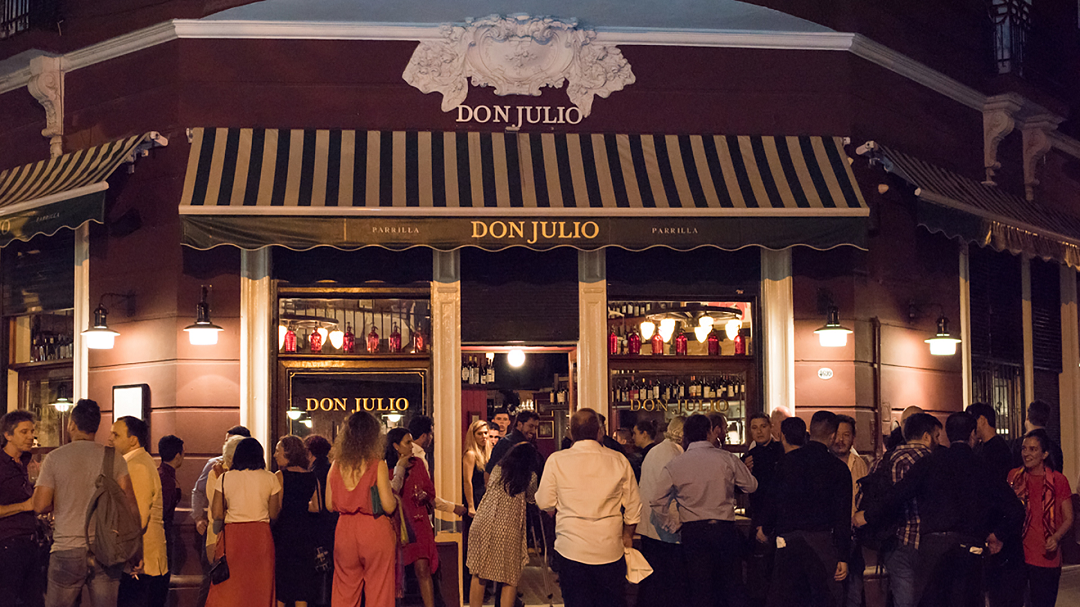Inspiration from one of the World’s Top Restaurants – Don Julio
One of our WISE employees, Tristyne, was traveling last month and filling up her ‘hospitality well’. She just returned from an amazing trip to Argentina and came back with some great insights. This trip was full of amazing wines and steak from Mendoza, but one of her favorite experiences was the opportunity to dine at Don Julio, 2020’s “Best Restaurant in Latin America”. This restaurant is currently rated the 2nd best in Latin America and #14 in the world, but these accolades weren’t just given to this restaurant. They were earned through hard work. But what is it about this restaurant that sets them apart and how does this relate to the wine industry?
“The new luxury has nothing to do with whether [a restaurant] is expensive or not. It has to do with the work that is done to show a terroir through its flavours. This is an award to a gastronomic culture more than to a cuisine. And this is our culture in Argentina, the culture of grilling, of embers, of breeding, of wine, of friends. That’s what Don Julio represents.” – Owner and Sommelier, Pablo Rivero
Before we make the connection to wineries, here are a few things that stood out as exemplary:
1) Desirability. This may be counterintuitive, but making us wait, in our opinion, was brilliant. To make a reservation here, you need to book 3-4 months in advance. But everyone wants to eat here, so what do they do? They have a small percentage of tables, staggered throughout the evening left unreserved, making room for walk-ins. But they don’t just take them as they come. Instead, “we were greeted and told that if we’d like to return at 9:00 (two hours later), they’d be happy to have us. We weren’t surprised – restaurant reviews clued us in, but we desired this experience enough to make it work. Two hours gave us time to leave, walk around Palermo for a while, get a drink and a snack at another nice restaurant, and return in time to join the party of people waiting outside their front doors,” she said.
2) Great Greeting. “Upon our return, they gave us sparkling wine from a well-known California winery. When I asked why something so difficult to obtain was being poured (Argentina has a very hard time importing from other countries), they said, “it’s for the people – it’s what the people like,” she continued. Talk about a great first impression! They even brought out empanadas from time to time, giving just enough enticement to stick around. Had they not done this well, people may have left with bad attitudes and free wine, but the wait and exclusivity made the experience even more desirable, and everyone was having so much fun conversing with each other, it added to the enjoyable experience.
3) Amazing Service & Experience. The staff was entirely welcoming of a party of 5, which included two children. Everyone, from the hosts to the bathroom cleaner was kind & helpful. Attire was nice, but not too fancy. Once seated, the menu, provided in Spanish and English, was well presented. They even had a “butcher bar” inside where you could see the different cuts of meat being offered. “We were brought exceptional bread & chimichurri, the steak was cut for me tableside by our server, and when they heard we were in the wine industry, we were offered a tour of their wine cellar.” And of course, the steak (paired with Malbec chosen from their extensive wine list) was phenomenal.
4) The Brand. Don Julio’s brand is unique and authentic. It’s true to Argentine culture, while anticipating the desires and needs of their guests. It’s classy and high-end, but not stuffy or pretentious. Moreover, it’s focused on quality over quantity.
Quality over Quantity
Why have we been going on about a restaurant? It’s not quite the same as a winery; it’s even in a different country. It all boils down to this – Don Julio provides a high-quality experience for everyone who walks through their doors. They realize they have a high volume of guests who want to dine there every day, too many to accommodate, but that’s ok. They set clear expectations, provide excellent service from start to finish, and as a result, they make a lot of money!
WISE has been hearing from more and more wineries concerned about volume. People are concerned that reservations are too inconvenient for guests or high-traffic locations such as ‘downtown,’ thus, some consider returning to the walk-in model commonly seen before the pandemic. Many wineries know they can count on the revenue for the tasting fees and can’t forecast for sales the same way, so it seems risky to limit the visitors/tasting fees.
Some wineries, especially those with larger estates, are turning their attention towards self-guided experiences – a way to entertain guests with limited staff. But our concern is that these ‘solutions’ are not helping wineries sell wine or possibly more importantly, their brand.
When people go wine tasting, they rarely go to just one winery. We don’t want to be the one they barely remember because they had a lackluster time – or remember all too well for the bad experience. Our mystery shopping results continue to prove that seated tastings focused on high-quality experiences lead to higher guest satisfaction (which leads to repeat business or recommendations).
Measuring Success: High guest satisfaction and the WISE Triple Score.
When it comes to metrics, perhaps there is an opportunity to reprioritize our top metrics. The best way to measure success? High guest satisfaction and the Triple Score. Of all your guests, how many guests purchased? How many joined the wine club? How many joined our mailing list? Yes, we want to have a high guest count, but let’s not set ourselves up for failure by accepting more guests than we can comfortably accommodate. It’s okay to say no (or better yet, not right now) to provide a better experience for everyone, instead of making compromises to accommodate more people for an ‘okay’ or potentially worse experience. We want our social reviews and mystery shopping results to be at a minimum of 4 out of 5. ‘Good’ experiences will keep the doors open, but “very good” or “excellent” give a competitive advantage and bring in repeat customers.
Conversion rates all have a common denominator of Guest Count. How about the average order size? If you know the guest count, and type of guest, you can start to really understand your metrics and how they compare to your neighbors. For wine sales, your conversion rate (Number of orders divided by the number of tasting room visitors) should be, at a minimum, 50% of every person who comes into the tasting room. This is a low-bar and typical in wineries who aren’t focused on sales. In a perfect world, 100% of our guests will purchase wine.
For the wine club, your conversion rate (Number of new club members divided by the number of tasting room visitors) should typically be between 8-12% – in other words, of all the people coming in who are not already club members or members of trade, for every 100 people at least 8 to 12 are signing up for the wine club. This is going to vary depending on the type of experience – lower for belly up to the bar or mixed group experience versus higher conversions for a seated, private experience.
Let’s take a minute to reflect – are we focused on quality or quantity? How can we be more like Don Julio? Can we create a sense of desirability; high end experiences that everyone wants, but only those prepared to spend are able to have, without being too pretentious or exclusive?




